Drug Therapy for Diabetes Type 2 and Chronic Kidney Disease
VerifiedAdded on 2023/01/13
|10
|2594
|29
AI Summary
This article discusses the correlation between diabetes type 2 and chronic kidney disease, the use of drug therapy to control blood sugar levels, and concerns regarding the addition of Glucovance. It also proposes medical inventions for the treatment of diabetes and chronic kidney disease.
Contribute Materials
Your contribution can guide someone’s learning journey. Share your
documents today.
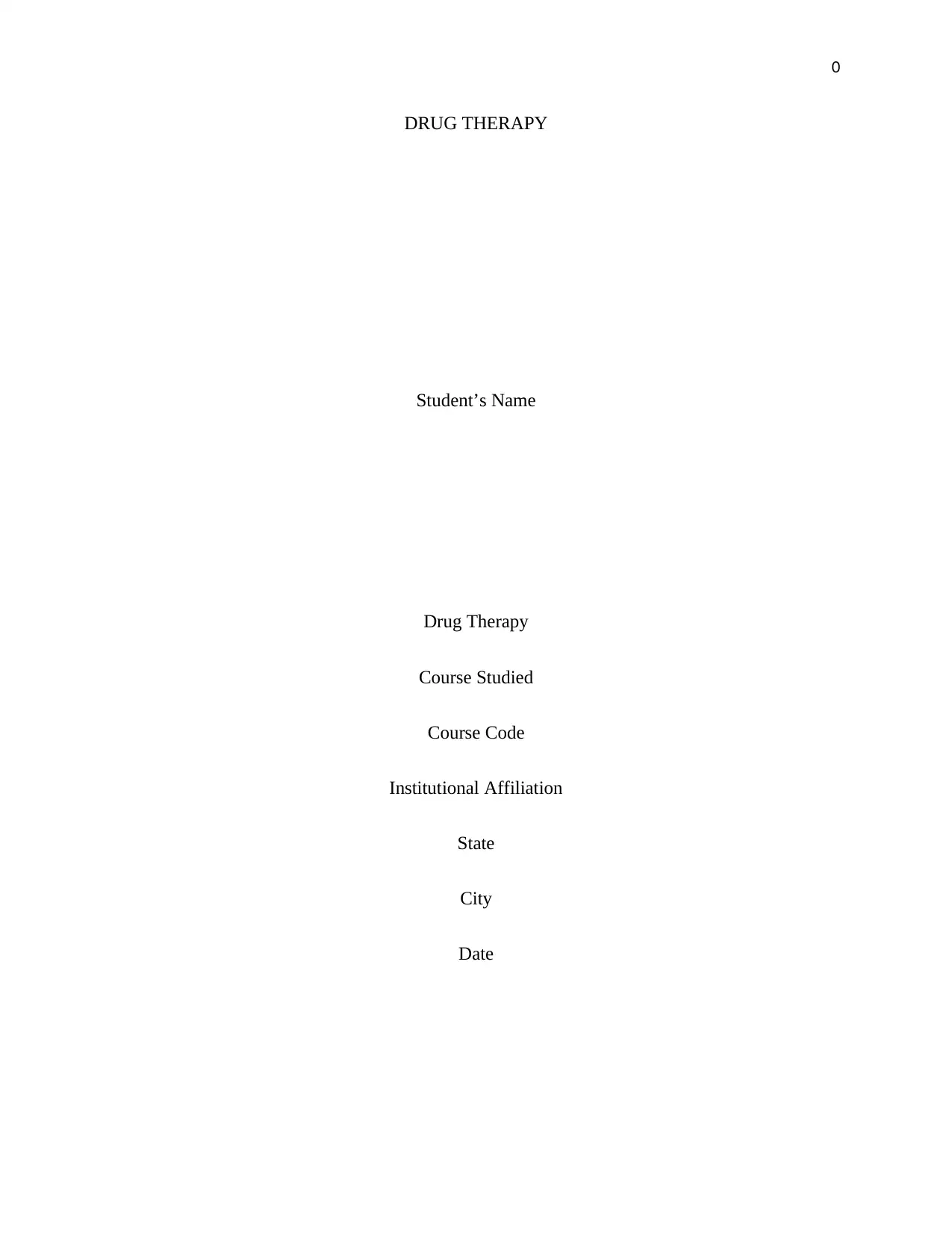
0
DRUG THERAPY
Student’s Name
Drug Therapy
Course Studied
Course Code
Institutional Affiliation
State
City
Date
DRUG THERAPY
Student’s Name
Drug Therapy
Course Studied
Course Code
Institutional Affiliation
State
City
Date
Secure Best Marks with AI Grader
Need help grading? Try our AI Grader for instant feedback on your assignments.
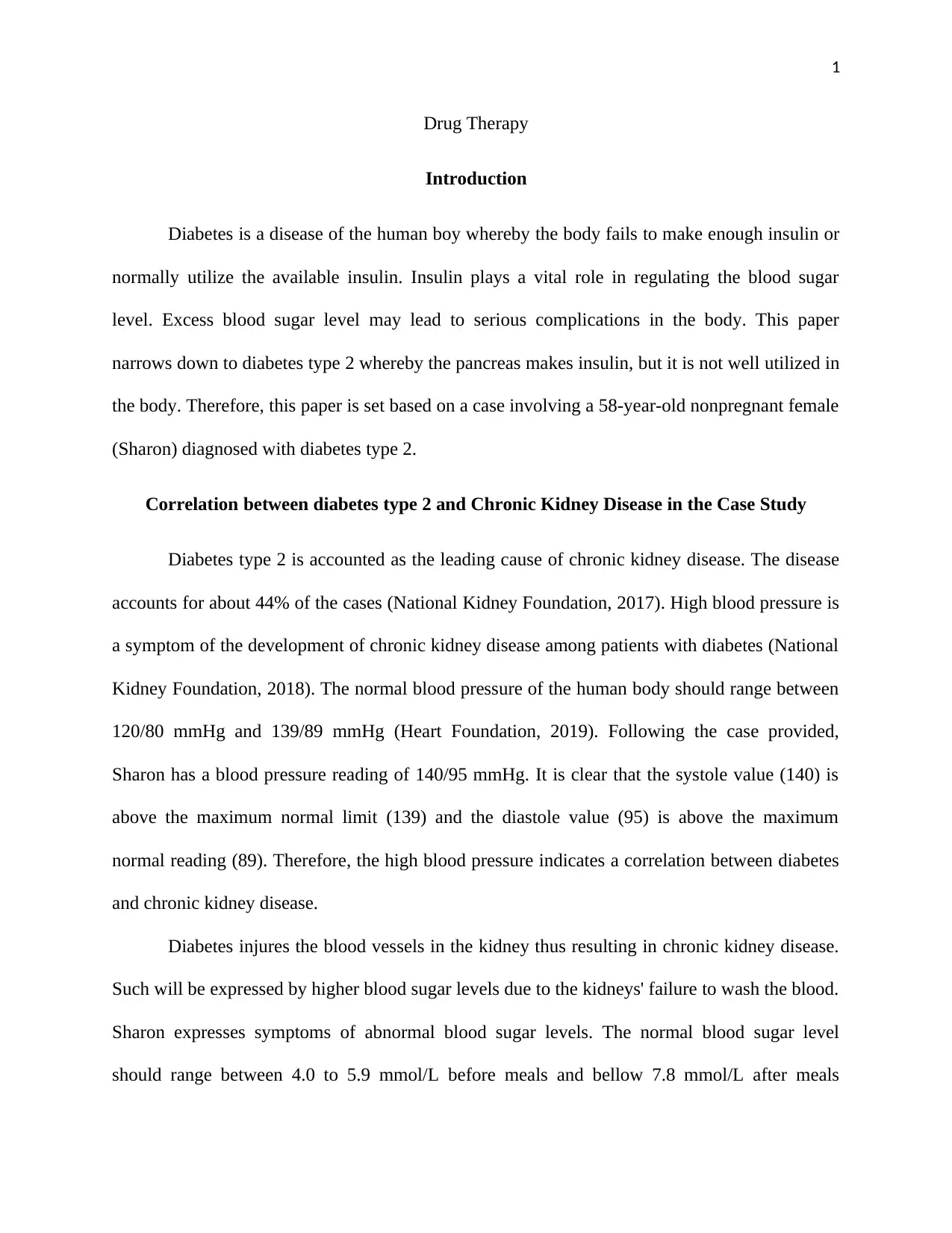
1
Drug Therapy
Introduction
Diabetes is a disease of the human boy whereby the body fails to make enough insulin or
normally utilize the available insulin. Insulin plays a vital role in regulating the blood sugar
level. Excess blood sugar level may lead to serious complications in the body. This paper
narrows down to diabetes type 2 whereby the pancreas makes insulin, but it is not well utilized in
the body. Therefore, this paper is set based on a case involving a 58-year-old nonpregnant female
(Sharon) diagnosed with diabetes type 2.
Correlation between diabetes type 2 and Chronic Kidney Disease in the Case Study
Diabetes type 2 is accounted as the leading cause of chronic kidney disease. The disease
accounts for about 44% of the cases (National Kidney Foundation, 2017). High blood pressure is
a symptom of the development of chronic kidney disease among patients with diabetes (National
Kidney Foundation, 2018). The normal blood pressure of the human body should range between
120/80 mmHg and 139/89 mmHg (Heart Foundation, 2019). Following the case provided,
Sharon has a blood pressure reading of 140/95 mmHg. It is clear that the systole value (140) is
above the maximum normal limit (139) and the diastole value (95) is above the maximum
normal reading (89). Therefore, the high blood pressure indicates a correlation between diabetes
and chronic kidney disease.
Diabetes injures the blood vessels in the kidney thus resulting in chronic kidney disease.
Such will be expressed by higher blood sugar levels due to the kidneys' failure to wash the blood.
Sharon expresses symptoms of abnormal blood sugar levels. The normal blood sugar level
should range between 4.0 to 5.9 mmol/L before meals and bellow 7.8 mmol/L after meals
Drug Therapy
Introduction
Diabetes is a disease of the human boy whereby the body fails to make enough insulin or
normally utilize the available insulin. Insulin plays a vital role in regulating the blood sugar
level. Excess blood sugar level may lead to serious complications in the body. This paper
narrows down to diabetes type 2 whereby the pancreas makes insulin, but it is not well utilized in
the body. Therefore, this paper is set based on a case involving a 58-year-old nonpregnant female
(Sharon) diagnosed with diabetes type 2.
Correlation between diabetes type 2 and Chronic Kidney Disease in the Case Study
Diabetes type 2 is accounted as the leading cause of chronic kidney disease. The disease
accounts for about 44% of the cases (National Kidney Foundation, 2017). High blood pressure is
a symptom of the development of chronic kidney disease among patients with diabetes (National
Kidney Foundation, 2018). The normal blood pressure of the human body should range between
120/80 mmHg and 139/89 mmHg (Heart Foundation, 2019). Following the case provided,
Sharon has a blood pressure reading of 140/95 mmHg. It is clear that the systole value (140) is
above the maximum normal limit (139) and the diastole value (95) is above the maximum
normal reading (89). Therefore, the high blood pressure indicates a correlation between diabetes
and chronic kidney disease.
Diabetes injures the blood vessels in the kidney thus resulting in chronic kidney disease.
Such will be expressed by higher blood sugar levels due to the kidneys' failure to wash the blood.
Sharon expresses symptoms of abnormal blood sugar levels. The normal blood sugar level
should range between 4.0 to 5.9 mmol/L before meals and bellow 7.8 mmol/L after meals
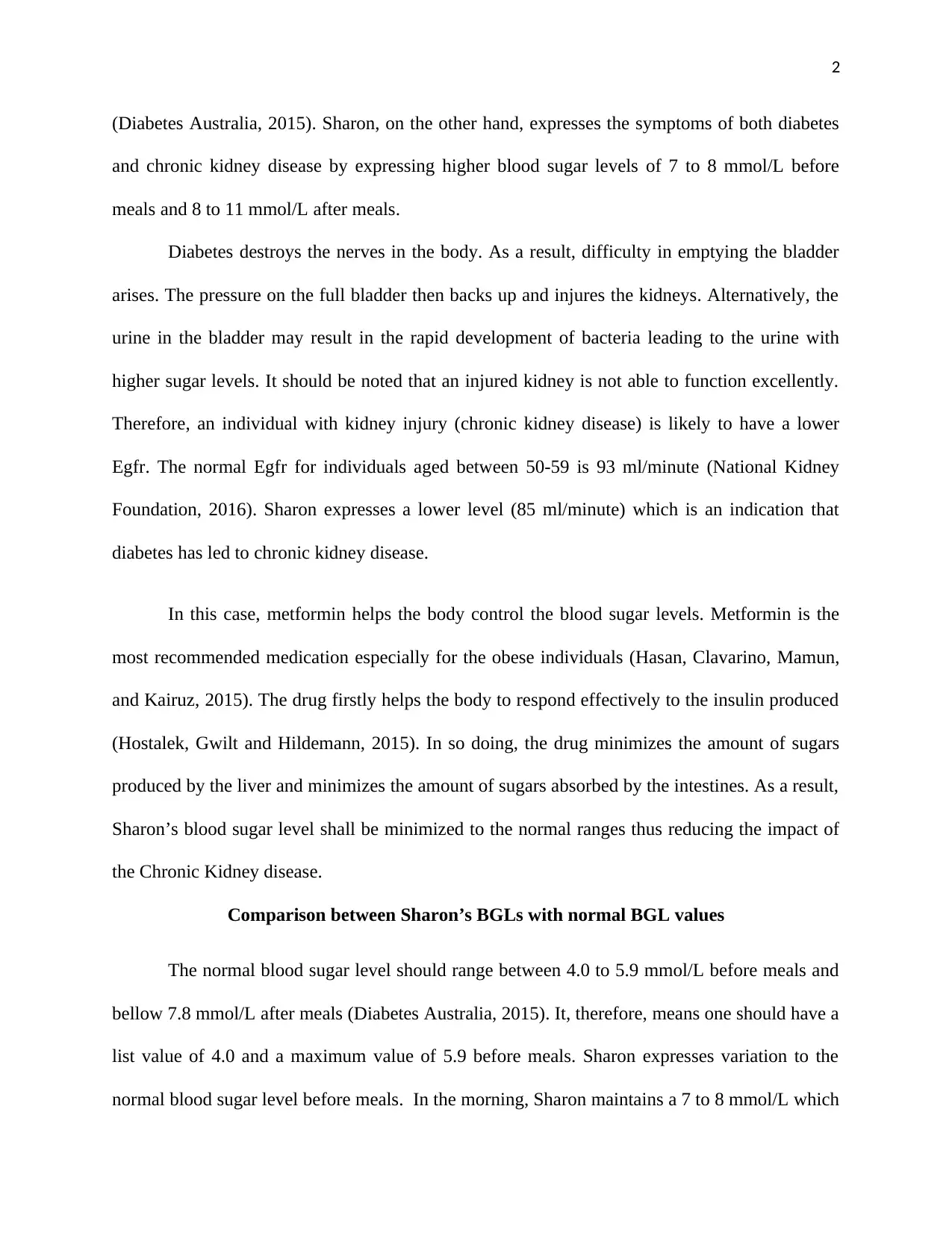
2
(Diabetes Australia, 2015). Sharon, on the other hand, expresses the symptoms of both diabetes
and chronic kidney disease by expressing higher blood sugar levels of 7 to 8 mmol/L before
meals and 8 to 11 mmol/L after meals.
Diabetes destroys the nerves in the body. As a result, difficulty in emptying the bladder
arises. The pressure on the full bladder then backs up and injures the kidneys. Alternatively, the
urine in the bladder may result in the rapid development of bacteria leading to the urine with
higher sugar levels. It should be noted that an injured kidney is not able to function excellently.
Therefore, an individual with kidney injury (chronic kidney disease) is likely to have a lower
Egfr. The normal Egfr for individuals aged between 50-59 is 93 ml/minute (National Kidney
Foundation, 2016). Sharon expresses a lower level (85 ml/minute) which is an indication that
diabetes has led to chronic kidney disease.
In this case, metformin helps the body control the blood sugar levels. Metformin is the
most recommended medication especially for the obese individuals (Hasan, Clavarino, Mamun,
and Kairuz, 2015). The drug firstly helps the body to respond effectively to the insulin produced
(Hostalek, Gwilt and Hildemann, 2015). In so doing, the drug minimizes the amount of sugars
produced by the liver and minimizes the amount of sugars absorbed by the intestines. As a result,
Sharon’s blood sugar level shall be minimized to the normal ranges thus reducing the impact of
the Chronic Kidney disease.
Comparison between Sharon’s BGLs with normal BGL values
The normal blood sugar level should range between 4.0 to 5.9 mmol/L before meals and
bellow 7.8 mmol/L after meals (Diabetes Australia, 2015). It, therefore, means one should have a
list value of 4.0 and a maximum value of 5.9 before meals. Sharon expresses variation to the
normal blood sugar level before meals. In the morning, Sharon maintains a 7 to 8 mmol/L which
(Diabetes Australia, 2015). Sharon, on the other hand, expresses the symptoms of both diabetes
and chronic kidney disease by expressing higher blood sugar levels of 7 to 8 mmol/L before
meals and 8 to 11 mmol/L after meals.
Diabetes destroys the nerves in the body. As a result, difficulty in emptying the bladder
arises. The pressure on the full bladder then backs up and injures the kidneys. Alternatively, the
urine in the bladder may result in the rapid development of bacteria leading to the urine with
higher sugar levels. It should be noted that an injured kidney is not able to function excellently.
Therefore, an individual with kidney injury (chronic kidney disease) is likely to have a lower
Egfr. The normal Egfr for individuals aged between 50-59 is 93 ml/minute (National Kidney
Foundation, 2016). Sharon expresses a lower level (85 ml/minute) which is an indication that
diabetes has led to chronic kidney disease.
In this case, metformin helps the body control the blood sugar levels. Metformin is the
most recommended medication especially for the obese individuals (Hasan, Clavarino, Mamun,
and Kairuz, 2015). The drug firstly helps the body to respond effectively to the insulin produced
(Hostalek, Gwilt and Hildemann, 2015). In so doing, the drug minimizes the amount of sugars
produced by the liver and minimizes the amount of sugars absorbed by the intestines. As a result,
Sharon’s blood sugar level shall be minimized to the normal ranges thus reducing the impact of
the Chronic Kidney disease.
Comparison between Sharon’s BGLs with normal BGL values
The normal blood sugar level should range between 4.0 to 5.9 mmol/L before meals and
bellow 7.8 mmol/L after meals (Diabetes Australia, 2015). It, therefore, means one should have a
list value of 4.0 and a maximum value of 5.9 before meals. Sharon expresses variation to the
normal blood sugar level before meals. In the morning, Sharon maintains a 7 to 8 mmol/L which
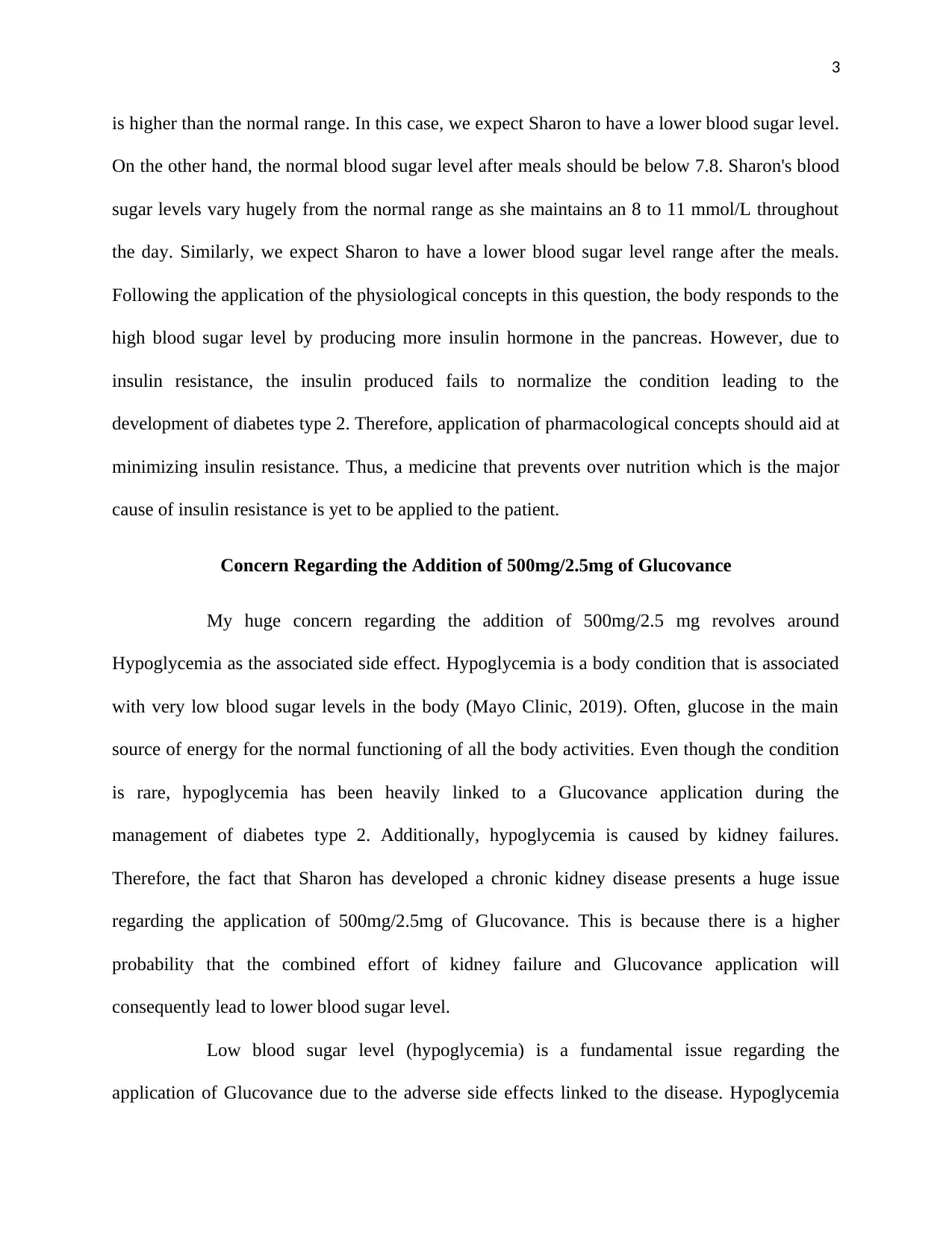
3
is higher than the normal range. In this case, we expect Sharon to have a lower blood sugar level.
On the other hand, the normal blood sugar level after meals should be below 7.8. Sharon's blood
sugar levels vary hugely from the normal range as she maintains an 8 to 11 mmol/L throughout
the day. Similarly, we expect Sharon to have a lower blood sugar level range after the meals.
Following the application of the physiological concepts in this question, the body responds to the
high blood sugar level by producing more insulin hormone in the pancreas. However, due to
insulin resistance, the insulin produced fails to normalize the condition leading to the
development of diabetes type 2. Therefore, application of pharmacological concepts should aid at
minimizing insulin resistance. Thus, a medicine that prevents over nutrition which is the major
cause of insulin resistance is yet to be applied to the patient.
Concern Regarding the Addition of 500mg/2.5mg of Glucovance
My huge concern regarding the addition of 500mg/2.5 mg revolves around
Hypoglycemia as the associated side effect. Hypoglycemia is a body condition that is associated
with very low blood sugar levels in the body (Mayo Clinic, 2019). Often, glucose in the main
source of energy for the normal functioning of all the body activities. Even though the condition
is rare, hypoglycemia has been heavily linked to a Glucovance application during the
management of diabetes type 2. Additionally, hypoglycemia is caused by kidney failures.
Therefore, the fact that Sharon has developed a chronic kidney disease presents a huge issue
regarding the application of 500mg/2.5mg of Glucovance. This is because there is a higher
probability that the combined effort of kidney failure and Glucovance application will
consequently lead to lower blood sugar level.
Low blood sugar level (hypoglycemia) is a fundamental issue regarding the
application of Glucovance due to the adverse side effects linked to the disease. Hypoglycemia
is higher than the normal range. In this case, we expect Sharon to have a lower blood sugar level.
On the other hand, the normal blood sugar level after meals should be below 7.8. Sharon's blood
sugar levels vary hugely from the normal range as she maintains an 8 to 11 mmol/L throughout
the day. Similarly, we expect Sharon to have a lower blood sugar level range after the meals.
Following the application of the physiological concepts in this question, the body responds to the
high blood sugar level by producing more insulin hormone in the pancreas. However, due to
insulin resistance, the insulin produced fails to normalize the condition leading to the
development of diabetes type 2. Therefore, application of pharmacological concepts should aid at
minimizing insulin resistance. Thus, a medicine that prevents over nutrition which is the major
cause of insulin resistance is yet to be applied to the patient.
Concern Regarding the Addition of 500mg/2.5mg of Glucovance
My huge concern regarding the addition of 500mg/2.5 mg revolves around
Hypoglycemia as the associated side effect. Hypoglycemia is a body condition that is associated
with very low blood sugar levels in the body (Mayo Clinic, 2019). Often, glucose in the main
source of energy for the normal functioning of all the body activities. Even though the condition
is rare, hypoglycemia has been heavily linked to a Glucovance application during the
management of diabetes type 2. Additionally, hypoglycemia is caused by kidney failures.
Therefore, the fact that Sharon has developed a chronic kidney disease presents a huge issue
regarding the application of 500mg/2.5mg of Glucovance. This is because there is a higher
probability that the combined effort of kidney failure and Glucovance application will
consequently lead to lower blood sugar level.
Low blood sugar level (hypoglycemia) is a fundamental issue regarding the
application of Glucovance due to the adverse side effects linked to the disease. Hypoglycemia
Secure Best Marks with AI Grader
Need help grading? Try our AI Grader for instant feedback on your assignments.
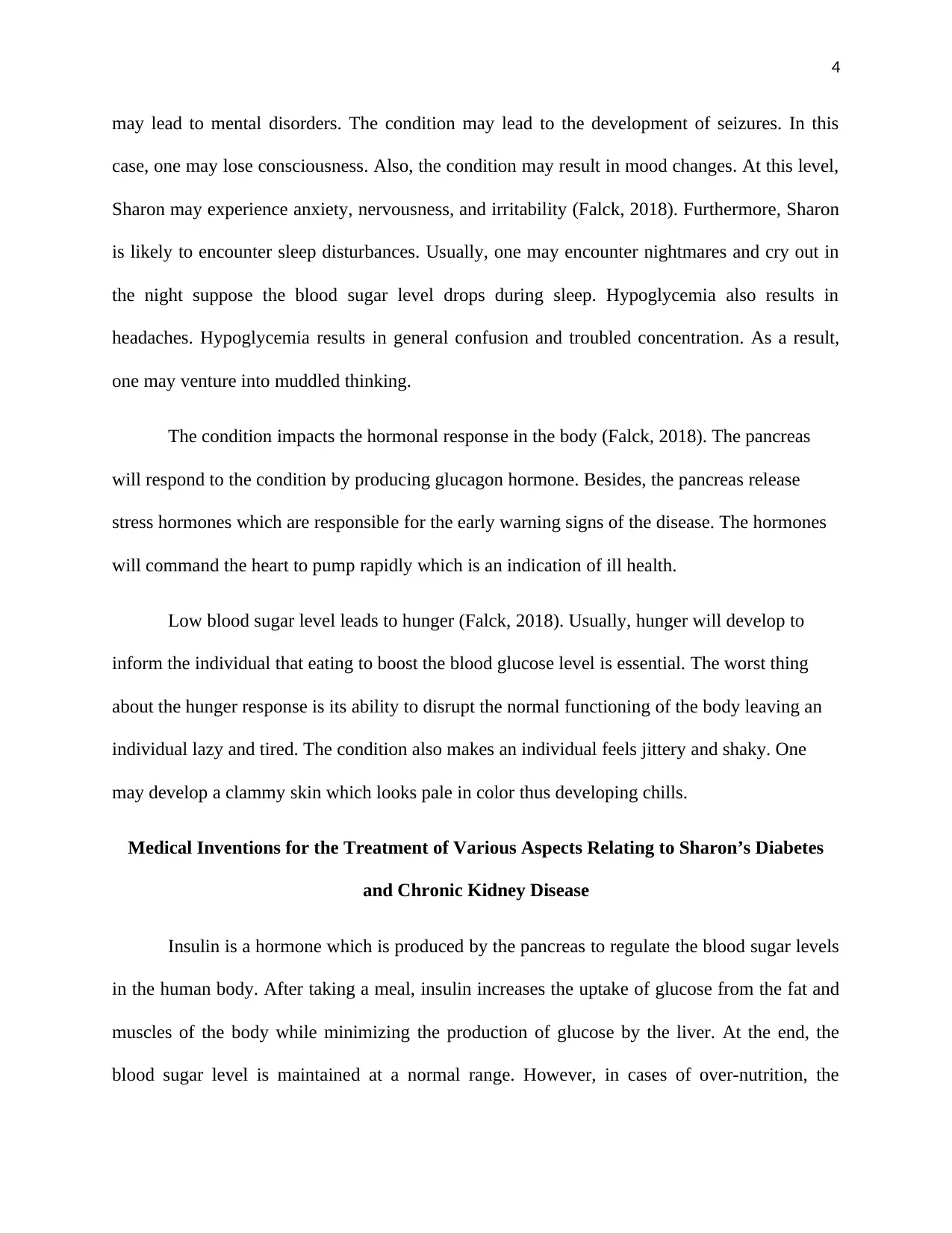
4
may lead to mental disorders. The condition may lead to the development of seizures. In this
case, one may lose consciousness. Also, the condition may result in mood changes. At this level,
Sharon may experience anxiety, nervousness, and irritability (Falck, 2018). Furthermore, Sharon
is likely to encounter sleep disturbances. Usually, one may encounter nightmares and cry out in
the night suppose the blood sugar level drops during sleep. Hypoglycemia also results in
headaches. Hypoglycemia results in general confusion and troubled concentration. As a result,
one may venture into muddled thinking.
The condition impacts the hormonal response in the body (Falck, 2018). The pancreas
will respond to the condition by producing glucagon hormone. Besides, the pancreas release
stress hormones which are responsible for the early warning signs of the disease. The hormones
will command the heart to pump rapidly which is an indication of ill health.
Low blood sugar level leads to hunger (Falck, 2018). Usually, hunger will develop to
inform the individual that eating to boost the blood glucose level is essential. The worst thing
about the hunger response is its ability to disrupt the normal functioning of the body leaving an
individual lazy and tired. The condition also makes an individual feels jittery and shaky. One
may develop a clammy skin which looks pale in color thus developing chills.
Medical Inventions for the Treatment of Various Aspects Relating to Sharon’s Diabetes
and Chronic Kidney Disease
Insulin is a hormone which is produced by the pancreas to regulate the blood sugar levels
in the human body. After taking a meal, insulin increases the uptake of glucose from the fat and
muscles of the body while minimizing the production of glucose by the liver. At the end, the
blood sugar level is maintained at a normal range. However, in cases of over-nutrition, the
may lead to mental disorders. The condition may lead to the development of seizures. In this
case, one may lose consciousness. Also, the condition may result in mood changes. At this level,
Sharon may experience anxiety, nervousness, and irritability (Falck, 2018). Furthermore, Sharon
is likely to encounter sleep disturbances. Usually, one may encounter nightmares and cry out in
the night suppose the blood sugar level drops during sleep. Hypoglycemia also results in
headaches. Hypoglycemia results in general confusion and troubled concentration. As a result,
one may venture into muddled thinking.
The condition impacts the hormonal response in the body (Falck, 2018). The pancreas
will respond to the condition by producing glucagon hormone. Besides, the pancreas release
stress hormones which are responsible for the early warning signs of the disease. The hormones
will command the heart to pump rapidly which is an indication of ill health.
Low blood sugar level leads to hunger (Falck, 2018). Usually, hunger will develop to
inform the individual that eating to boost the blood glucose level is essential. The worst thing
about the hunger response is its ability to disrupt the normal functioning of the body leaving an
individual lazy and tired. The condition also makes an individual feels jittery and shaky. One
may develop a clammy skin which looks pale in color thus developing chills.
Medical Inventions for the Treatment of Various Aspects Relating to Sharon’s Diabetes
and Chronic Kidney Disease
Insulin is a hormone which is produced by the pancreas to regulate the blood sugar levels
in the human body. After taking a meal, insulin increases the uptake of glucose from the fat and
muscles of the body while minimizing the production of glucose by the liver. At the end, the
blood sugar level is maintained at a normal range. However, in cases of over-nutrition, the
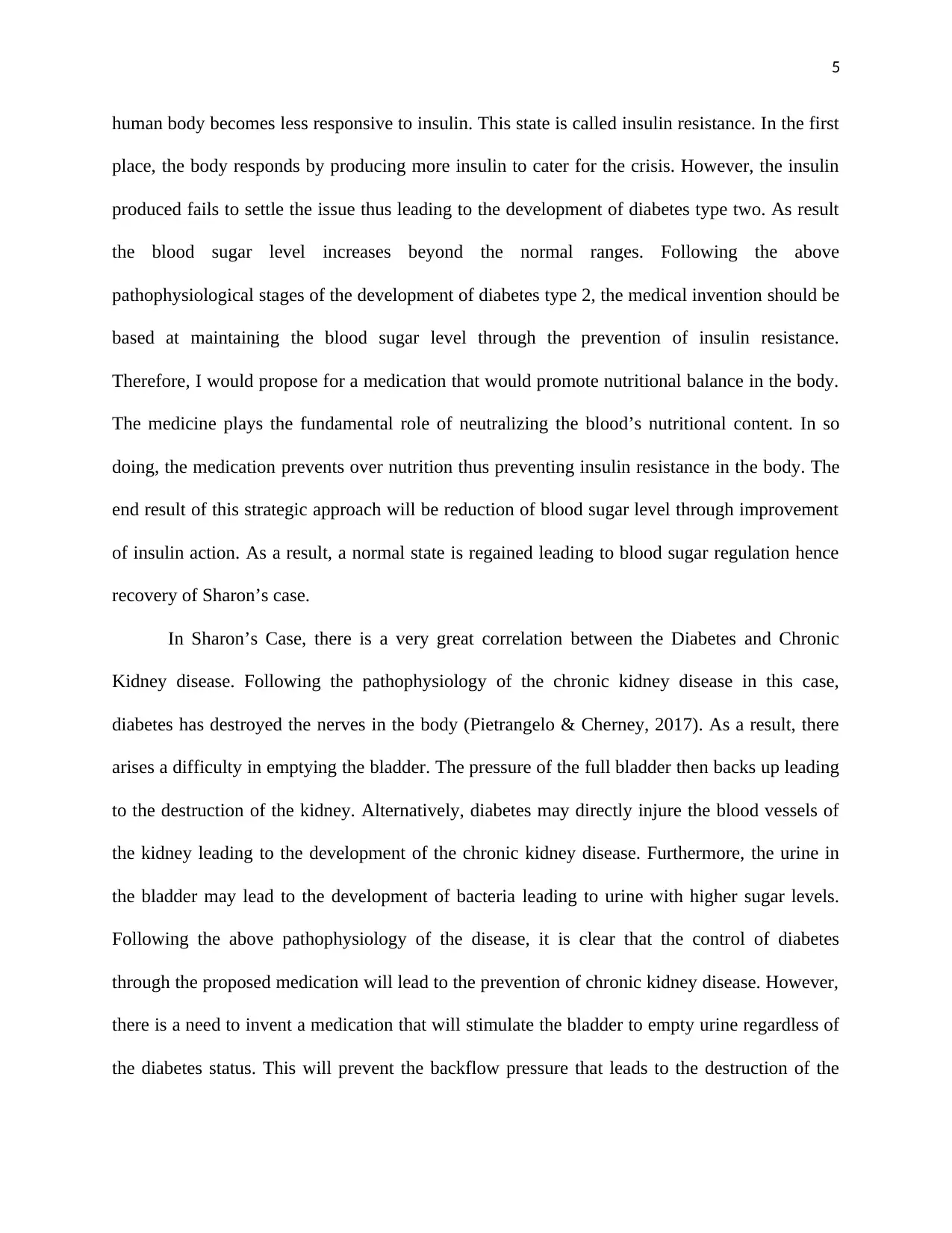
5
human body becomes less responsive to insulin. This state is called insulin resistance. In the first
place, the body responds by producing more insulin to cater for the crisis. However, the insulin
produced fails to settle the issue thus leading to the development of diabetes type two. As result
the blood sugar level increases beyond the normal ranges. Following the above
pathophysiological stages of the development of diabetes type 2, the medical invention should be
based at maintaining the blood sugar level through the prevention of insulin resistance.
Therefore, I would propose for a medication that would promote nutritional balance in the body.
The medicine plays the fundamental role of neutralizing the blood’s nutritional content. In so
doing, the medication prevents over nutrition thus preventing insulin resistance in the body. The
end result of this strategic approach will be reduction of blood sugar level through improvement
of insulin action. As a result, a normal state is regained leading to blood sugar regulation hence
recovery of Sharon’s case.
In Sharon’s Case, there is a very great correlation between the Diabetes and Chronic
Kidney disease. Following the pathophysiology of the chronic kidney disease in this case,
diabetes has destroyed the nerves in the body (Pietrangelo & Cherney, 2017). As a result, there
arises a difficulty in emptying the bladder. The pressure of the full bladder then backs up leading
to the destruction of the kidney. Alternatively, diabetes may directly injure the blood vessels of
the kidney leading to the development of the chronic kidney disease. Furthermore, the urine in
the bladder may lead to the development of bacteria leading to urine with higher sugar levels.
Following the above pathophysiology of the disease, it is clear that the control of diabetes
through the proposed medication will lead to the prevention of chronic kidney disease. However,
there is a need to invent a medication that will stimulate the bladder to empty urine regardless of
the diabetes status. This will prevent the backflow pressure that leads to the destruction of the
human body becomes less responsive to insulin. This state is called insulin resistance. In the first
place, the body responds by producing more insulin to cater for the crisis. However, the insulin
produced fails to settle the issue thus leading to the development of diabetes type two. As result
the blood sugar level increases beyond the normal ranges. Following the above
pathophysiological stages of the development of diabetes type 2, the medical invention should be
based at maintaining the blood sugar level through the prevention of insulin resistance.
Therefore, I would propose for a medication that would promote nutritional balance in the body.
The medicine plays the fundamental role of neutralizing the blood’s nutritional content. In so
doing, the medication prevents over nutrition thus preventing insulin resistance in the body. The
end result of this strategic approach will be reduction of blood sugar level through improvement
of insulin action. As a result, a normal state is regained leading to blood sugar regulation hence
recovery of Sharon’s case.
In Sharon’s Case, there is a very great correlation between the Diabetes and Chronic
Kidney disease. Following the pathophysiology of the chronic kidney disease in this case,
diabetes has destroyed the nerves in the body (Pietrangelo & Cherney, 2017). As a result, there
arises a difficulty in emptying the bladder. The pressure of the full bladder then backs up leading
to the destruction of the kidney. Alternatively, diabetes may directly injure the blood vessels of
the kidney leading to the development of the chronic kidney disease. Furthermore, the urine in
the bladder may lead to the development of bacteria leading to urine with higher sugar levels.
Following the above pathophysiology of the disease, it is clear that the control of diabetes
through the proposed medication will lead to the prevention of chronic kidney disease. However,
there is a need to invent a medication that will stimulate the bladder to empty urine regardless of
the diabetes status. This will prevent the backflow pressure that leads to the destruction of the
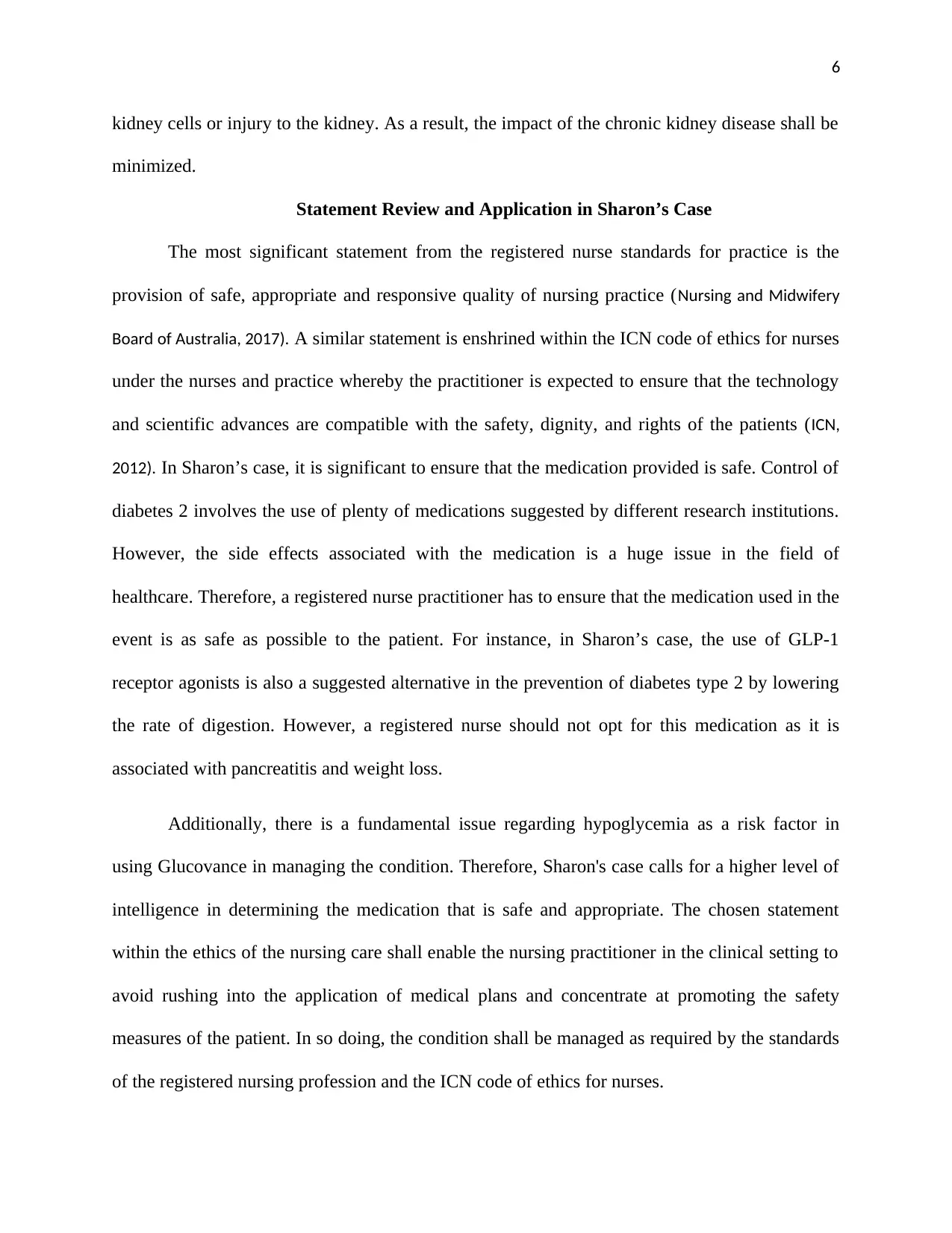
6
kidney cells or injury to the kidney. As a result, the impact of the chronic kidney disease shall be
minimized.
Statement Review and Application in Sharon’s Case
The most significant statement from the registered nurse standards for practice is the
provision of safe, appropriate and responsive quality of nursing practice (Nursing and Midwifery
Board of Australia, 2017). A similar statement is enshrined within the ICN code of ethics for nurses
under the nurses and practice whereby the practitioner is expected to ensure that the technology
and scientific advances are compatible with the safety, dignity, and rights of the patients (ICN,
2012). In Sharon’s case, it is significant to ensure that the medication provided is safe. Control of
diabetes 2 involves the use of plenty of medications suggested by different research institutions.
However, the side effects associated with the medication is a huge issue in the field of
healthcare. Therefore, a registered nurse practitioner has to ensure that the medication used in the
event is as safe as possible to the patient. For instance, in Sharon’s case, the use of GLP-1
receptor agonists is also a suggested alternative in the prevention of diabetes type 2 by lowering
the rate of digestion. However, a registered nurse should not opt for this medication as it is
associated with pancreatitis and weight loss.
Additionally, there is a fundamental issue regarding hypoglycemia as a risk factor in
using Glucovance in managing the condition. Therefore, Sharon's case calls for a higher level of
intelligence in determining the medication that is safe and appropriate. The chosen statement
within the ethics of the nursing care shall enable the nursing practitioner in the clinical setting to
avoid rushing into the application of medical plans and concentrate at promoting the safety
measures of the patient. In so doing, the condition shall be managed as required by the standards
of the registered nursing profession and the ICN code of ethics for nurses.
kidney cells or injury to the kidney. As a result, the impact of the chronic kidney disease shall be
minimized.
Statement Review and Application in Sharon’s Case
The most significant statement from the registered nurse standards for practice is the
provision of safe, appropriate and responsive quality of nursing practice (Nursing and Midwifery
Board of Australia, 2017). A similar statement is enshrined within the ICN code of ethics for nurses
under the nurses and practice whereby the practitioner is expected to ensure that the technology
and scientific advances are compatible with the safety, dignity, and rights of the patients (ICN,
2012). In Sharon’s case, it is significant to ensure that the medication provided is safe. Control of
diabetes 2 involves the use of plenty of medications suggested by different research institutions.
However, the side effects associated with the medication is a huge issue in the field of
healthcare. Therefore, a registered nurse practitioner has to ensure that the medication used in the
event is as safe as possible to the patient. For instance, in Sharon’s case, the use of GLP-1
receptor agonists is also a suggested alternative in the prevention of diabetes type 2 by lowering
the rate of digestion. However, a registered nurse should not opt for this medication as it is
associated with pancreatitis and weight loss.
Additionally, there is a fundamental issue regarding hypoglycemia as a risk factor in
using Glucovance in managing the condition. Therefore, Sharon's case calls for a higher level of
intelligence in determining the medication that is safe and appropriate. The chosen statement
within the ethics of the nursing care shall enable the nursing practitioner in the clinical setting to
avoid rushing into the application of medical plans and concentrate at promoting the safety
measures of the patient. In so doing, the condition shall be managed as required by the standards
of the registered nursing profession and the ICN code of ethics for nurses.
Paraphrase This Document
Need a fresh take? Get an instant paraphrase of this document with our AI Paraphraser
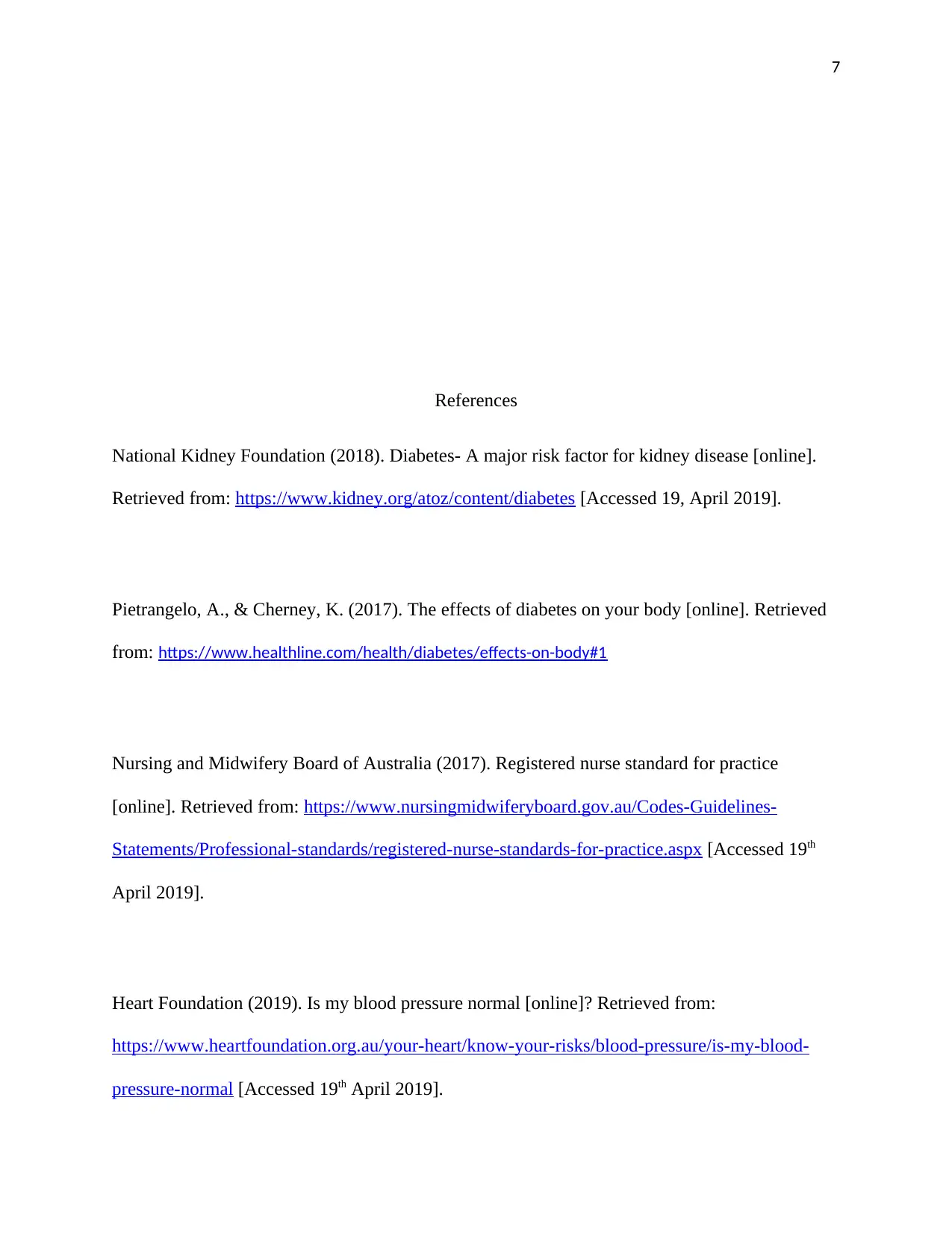
7
References
National Kidney Foundation (2018). Diabetes- A major risk factor for kidney disease [online].
Retrieved from: https://www.kidney.org/atoz/content/diabetes [Accessed 19, April 2019].
Pietrangelo, A., & Cherney, K. (2017). The effects of diabetes on your body [online]. Retrieved
from: https://www.healthline.com/health/diabetes/effects-on-body#1
Nursing and Midwifery Board of Australia (2017). Registered nurse standard for practice
[online]. Retrieved from: https://www.nursingmidwiferyboard.gov.au/Codes-Guidelines-
Statements/Professional-standards/registered-nurse-standards-for-practice.aspx [Accessed 19th
April 2019].
Heart Foundation (2019). Is my blood pressure normal [online]? Retrieved from:
https://www.heartfoundation.org.au/your-heart/know-your-risks/blood-pressure/is-my-blood-
pressure-normal [Accessed 19th April 2019].
References
National Kidney Foundation (2018). Diabetes- A major risk factor for kidney disease [online].
Retrieved from: https://www.kidney.org/atoz/content/diabetes [Accessed 19, April 2019].
Pietrangelo, A., & Cherney, K. (2017). The effects of diabetes on your body [online]. Retrieved
from: https://www.healthline.com/health/diabetes/effects-on-body#1
Nursing and Midwifery Board of Australia (2017). Registered nurse standard for practice
[online]. Retrieved from: https://www.nursingmidwiferyboard.gov.au/Codes-Guidelines-
Statements/Professional-standards/registered-nurse-standards-for-practice.aspx [Accessed 19th
April 2019].
Heart Foundation (2019). Is my blood pressure normal [online]? Retrieved from:
https://www.heartfoundation.org.au/your-heart/know-your-risks/blood-pressure/is-my-blood-
pressure-normal [Accessed 19th April 2019].
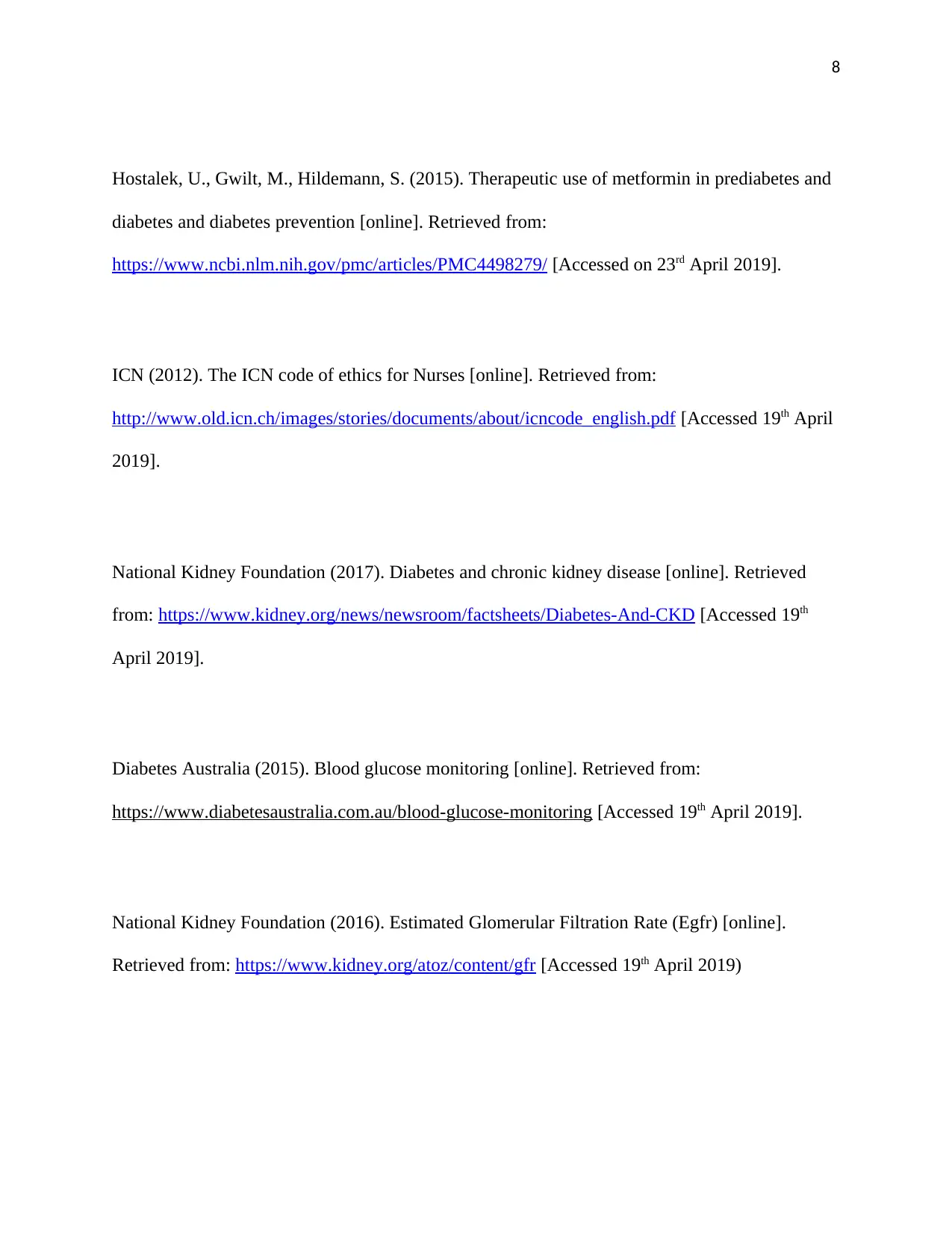
8
Hostalek, U., Gwilt, M., Hildemann, S. (2015). Therapeutic use of metformin in prediabetes and
diabetes and diabetes prevention [online]. Retrieved from:
https://www.ncbi.nlm.nih.gov/pmc/articles/PMC4498279/ [Accessed on 23rd April 2019].
ICN (2012). The ICN code of ethics for Nurses [online]. Retrieved from:
http://www.old.icn.ch/images/stories/documents/about/icncode_english.pdf [Accessed 19th April
2019].
National Kidney Foundation (2017). Diabetes and chronic kidney disease [online]. Retrieved
from: https://www.kidney.org/news/newsroom/factsheets/Diabetes-And-CKD [Accessed 19th
April 2019].
Diabetes Australia (2015). Blood glucose monitoring [online]. Retrieved from:
https://www.diabetesaustralia.com.au/blood-glucose-monitoring [Accessed 19th April 2019].
National Kidney Foundation (2016). Estimated Glomerular Filtration Rate (Egfr) [online].
Retrieved from: https://www.kidney.org/atoz/content/gfr [Accessed 19th April 2019)
Hostalek, U., Gwilt, M., Hildemann, S. (2015). Therapeutic use of metformin in prediabetes and
diabetes and diabetes prevention [online]. Retrieved from:
https://www.ncbi.nlm.nih.gov/pmc/articles/PMC4498279/ [Accessed on 23rd April 2019].
ICN (2012). The ICN code of ethics for Nurses [online]. Retrieved from:
http://www.old.icn.ch/images/stories/documents/about/icncode_english.pdf [Accessed 19th April
2019].
National Kidney Foundation (2017). Diabetes and chronic kidney disease [online]. Retrieved
from: https://www.kidney.org/news/newsroom/factsheets/Diabetes-And-CKD [Accessed 19th
April 2019].
Diabetes Australia (2015). Blood glucose monitoring [online]. Retrieved from:
https://www.diabetesaustralia.com.au/blood-glucose-monitoring [Accessed 19th April 2019].
National Kidney Foundation (2016). Estimated Glomerular Filtration Rate (Egfr) [online].
Retrieved from: https://www.kidney.org/atoz/content/gfr [Accessed 19th April 2019)
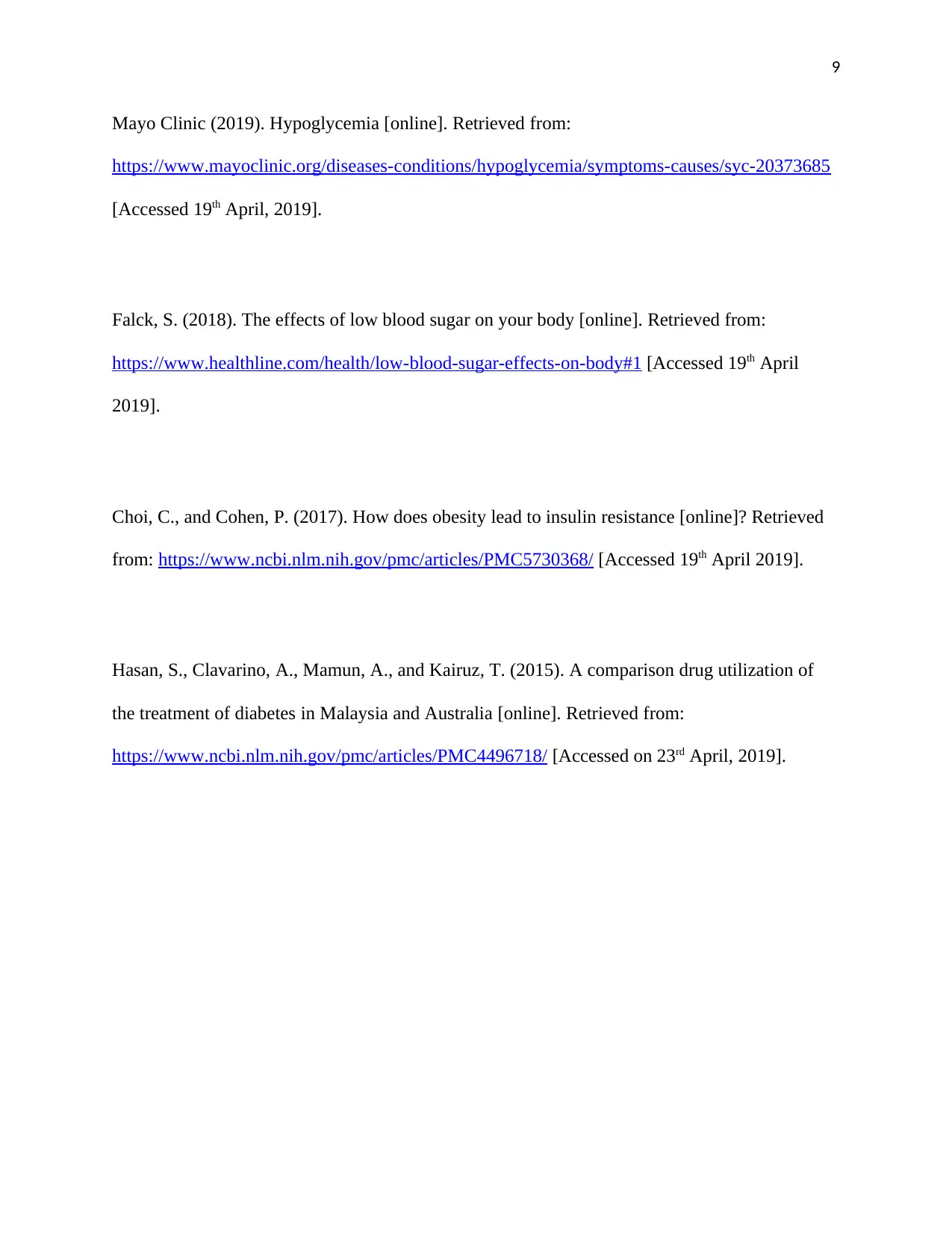
9
Mayo Clinic (2019). Hypoglycemia [online]. Retrieved from:
https://www.mayoclinic.org/diseases-conditions/hypoglycemia/symptoms-causes/syc-20373685
[Accessed 19th April, 2019].
Falck, S. (2018). The effects of low blood sugar on your body [online]. Retrieved from:
https://www.healthline.com/health/low-blood-sugar-effects-on-body#1 [Accessed 19th April
2019].
Choi, C., and Cohen, P. (2017). How does obesity lead to insulin resistance [online]? Retrieved
from: https://www.ncbi.nlm.nih.gov/pmc/articles/PMC5730368/ [Accessed 19th April 2019].
Hasan, S., Clavarino, A., Mamun, A., and Kairuz, T. (2015). A comparison drug utilization of
the treatment of diabetes in Malaysia and Australia [online]. Retrieved from:
https://www.ncbi.nlm.nih.gov/pmc/articles/PMC4496718/ [Accessed on 23rd April, 2019].
Mayo Clinic (2019). Hypoglycemia [online]. Retrieved from:
https://www.mayoclinic.org/diseases-conditions/hypoglycemia/symptoms-causes/syc-20373685
[Accessed 19th April, 2019].
Falck, S. (2018). The effects of low blood sugar on your body [online]. Retrieved from:
https://www.healthline.com/health/low-blood-sugar-effects-on-body#1 [Accessed 19th April
2019].
Choi, C., and Cohen, P. (2017). How does obesity lead to insulin resistance [online]? Retrieved
from: https://www.ncbi.nlm.nih.gov/pmc/articles/PMC5730368/ [Accessed 19th April 2019].
Hasan, S., Clavarino, A., Mamun, A., and Kairuz, T. (2015). A comparison drug utilization of
the treatment of diabetes in Malaysia and Australia [online]. Retrieved from:
https://www.ncbi.nlm.nih.gov/pmc/articles/PMC4496718/ [Accessed on 23rd April, 2019].
1 out of 10
Related Documents
Your All-in-One AI-Powered Toolkit for Academic Success.
+13062052269
info@desklib.com
Available 24*7 on WhatsApp / Email
![[object Object]](/_next/static/media/star-bottom.7253800d.svg)
Unlock your academic potential
© 2024 | Zucol Services PVT LTD | All rights reserved.





